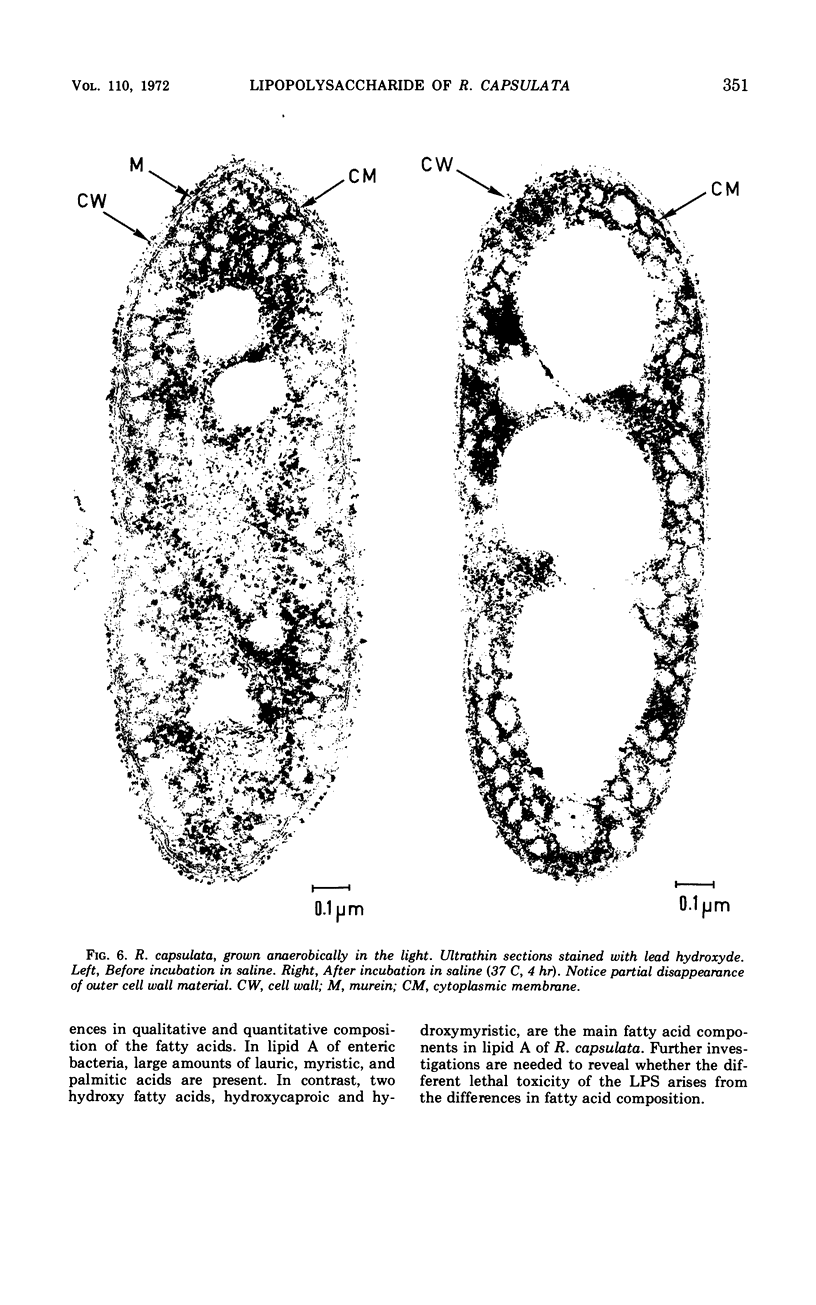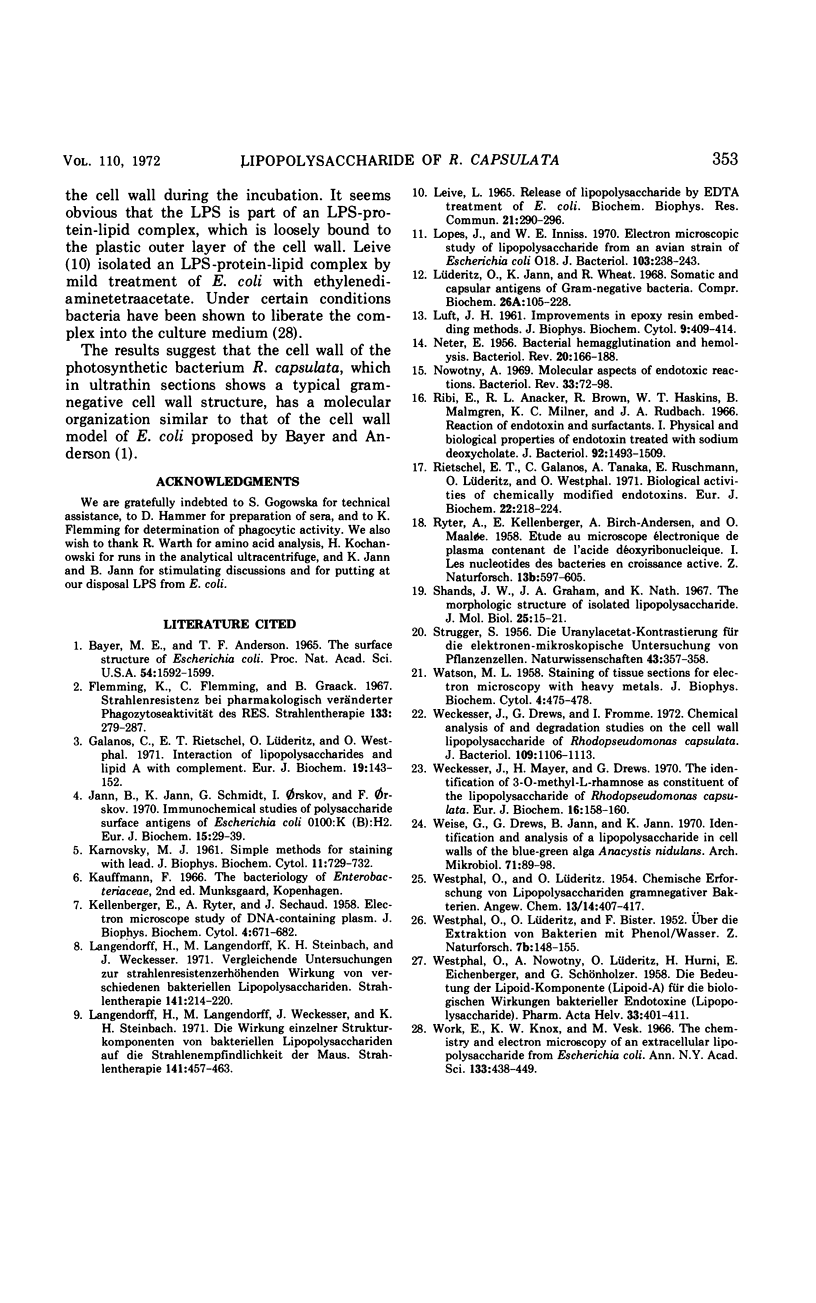Abstract
Electron micrographs of phenol-water-extracted lipopolysaccharide (LPS) of Rhodopseudomonas capsulata show filamentous and netlike aggregates. Treatment of the LPS with sodium deoxycholate resulted in a reversible splitting into subunits. The LPS represents a cell wall constituent with O-antigenic specificity. In passive hemagglutination tests, high titers were obtained when erythrocytes sensitized with untreated or heat-treated LPS were incubated with antisera obtained by immunization of rabbits with whole cells of R. capsulata. The alkali-treated LPS was not active in this test. Mouse lethality tests have shown that the LPS of R. capsulata is less toxic than LPS of Escherichia coli. Also, the X-ray protection efficacy and the phagocytic activity stimulation of LPS from R. capsulata in mice are small, as compared with LPS of E. coli. Incubation of living bacteria in saline (37 C) resulted in a solubilization of an LPS-protein-lipid complex from the outer layer of the cell wall. The isolated complex contained the components which were found in the LPS. In addition, 20% amino acids and a large amount of palmitic and stearic acids, which are typical phospholipid components, were present.
Full text
PDF







Images in this article
Selected References
These references are in PubMed. This may not be the complete list of references from this article.
- Bayer M. E., Anderson T. F. The surface structure of Escherichia coli. Proc Natl Acad Sci U S A. 1965 Dec;54(6):1592–1599. doi: 10.1073/pnas.54.6.1592. [DOI] [PMC free article] [PubMed] [Google Scholar]
- Flemming K., Flemming C., Graack B. Strahlenresistenz bei pharmakologisch veränderter Phagozytoseaktivität des RES. Strahlentherapie. 1967 Jun;133(2):280–287. [PubMed] [Google Scholar]
- Galanos C., Rietschel E. T., Lüderitz O., Westphal O. Interaction of lipopolysaccharides and lipid A with complement. Eur J Biochem. 1971 Mar 1;19(1):143–152. doi: 10.1111/j.1432-1033.1971.tb01298.x. [DOI] [PubMed] [Google Scholar]
- Jann B., Jann K., Schmidt G., Orskov I., Orskov F. Immunochemical studies of polysaccharide surface antigens of Escherichia coli 0100:K?(B):H2. Eur J Biochem. 1970 Jul;15(1):29–39. doi: 10.1111/j.1432-1033.1970.tb00972.x. [DOI] [PubMed] [Google Scholar]
- KARNOVSKY M. J. Simple methods for "staining with lead" at high pH in electron microscopy. J Biophys Biochem Cytol. 1961 Dec;11:729–732. doi: 10.1083/jcb.11.3.729. [DOI] [PMC free article] [PubMed] [Google Scholar]
- KELLENBERGER E., RYTER A., SECHAUD J. Electron microscope study of DNA-containing plasms. II. Vegetative and mature phage DNA as compared with normal bacterial nucleoids in different physiological states. J Biophys Biochem Cytol. 1958 Nov 25;4(6):671–678. doi: 10.1083/jcb.4.6.671. [DOI] [PMC free article] [PubMed] [Google Scholar]
- LUFT J. H. Improvements in epoxy resin embedding methods. J Biophys Biochem Cytol. 1961 Feb;9:409–414. doi: 10.1083/jcb.9.2.409. [DOI] [PMC free article] [PubMed] [Google Scholar]
- Langendorff H., Langendorff M., Steinbach K. H., Weckesser J. Vergleichende Untersuchungen zur strahlenresistenzerhöhenden Wirkung von verschiedenen bakteriellen Lipopolysacchariden. Strahlentherapie. 1971;141(2):214–220. [PubMed] [Google Scholar]
- Langendorff H., Langendorff M., Weckesser J., Steinbach K. H. Die Wirkung einzelner Strukturkomponenteen von bakteriellen Lipopolysacchariden auf die Strahlenempfindlichkeit der Maus. Strahlentherapie. 1971 Apr;141(4):457–463. [PubMed] [Google Scholar]
- Leive L. Release of lipopolysaccharide by EDTA treatment of E. coli. Biochem Biophys Res Commun. 1965 Nov 22;21(4):290–296. doi: 10.1016/0006-291x(65)90191-9. [DOI] [PubMed] [Google Scholar]
- Lopes J., Inniss W. E. Electron microscopic study of lipopolysaccharide from an avian strain of Escherichia coli O18. J Bacteriol. 1970 Jul;103(1):238–243. doi: 10.1128/jb.103.1.238-243.1970. [DOI] [PMC free article] [PubMed] [Google Scholar]
- NETER E. Bacterial hemagglutination and hemolysis. Bacteriol Rev. 1956 Sep;20(3):166–188. doi: 10.1128/br.20.3.166-188.1956. [DOI] [PMC free article] [PubMed] [Google Scholar]
- Nowotny A. Molecular aspects of endotoxic reactions. Bacteriol Rev. 1969 Mar;33(1):72–98. doi: 10.1128/br.33.1.72-98.1969. [DOI] [PMC free article] [PubMed] [Google Scholar]
- RYTER A., KELLENBERGER E., BIRCHANDERSEN A., MAALOE O. Etude au microscope électronique de plasmas contenant de l'acide désoxyribonucliéique. I. Les nucléoides des bactéries en croissance active. Z Naturforsch B. 1958 Sep;13B(9):597–605. [PubMed] [Google Scholar]
- Ribi E., Anacker R. L., Brown R., Haskins W. T., Malmgren B., Milner K. C., Rudbach J. A. Reaction of endotoxin and surfactants. I. Physical and biological properties of endotoxin treated with sodium deoxycholate. J Bacteriol. 1966 Nov;92(5):1493–1509. doi: 10.1128/jb.92.5.1493-1509.1966. [DOI] [PMC free article] [PubMed] [Google Scholar]
- Rietschel E. T., Galanos C., Tanaka A., Ruschmann E., Lüderitz O., Westphal O. Biological activities of chemically modified endotoxins. Eur J Biochem. 1971 Sep 24;22(2):218–224. doi: 10.1111/j.1432-1033.1971.tb01535.x. [DOI] [PubMed] [Google Scholar]
- Shands J. W., Jr, Graham J. A., Nath K. The morphologic structure of isolated bacterial lipopolysaccharide. J Mol Biol. 1967 Apr 14;25(1):15–21. doi: 10.1016/0022-2836(67)90275-6. [DOI] [PubMed] [Google Scholar]
- WATSON M. L. Staining of tissue sections for electron microscopy with heavy metals. J Biophys Biochem Cytol. 1958 Jul 25;4(4):475–478. doi: 10.1083/jcb.4.4.475. [DOI] [PMC free article] [PubMed] [Google Scholar]
- WESTPHAL O., NOWOTNY A., LUDERITZ O., HURNI H., EICHENBERGER E., SCHONHOLZER G. Die Bedeutung der Lipoid-Komponente (Lipoid A) für die biologischen Wirkungen bakterieller Endotoxine (Lipopolysaccharide). Pharm Acta Helv. 1958 Aug-Oct;33(8-10):401–411. [PubMed] [Google Scholar]
- Weckesser J., Drews G., Fromme I. Chemical analysis of and degradation studies on the cell wall lipopolysaccharide of Rhodopseudomonas capsulata. J Bacteriol. 1972 Mar;109(3):1106–1113. doi: 10.1128/jb.109.3.1106-1113.1972. [DOI] [PMC free article] [PubMed] [Google Scholar]
- Weckesser J., Mayer H., Drews G. The identification of 3-O-methyl-L-rhamnose (L-acofriose) as constituent of the lipopolysaccharide of Rhodopseudomonas capsulata. Eur J Biochem. 1970 Sep;16(1):158–160. doi: 10.1111/j.1432-1033.1970.tb01067.x. [DOI] [PubMed] [Google Scholar]
- Weise G., Drews G., Jann B., Jann K. Identification and analysis of a lipopolysaccharide in cell walls of the blue-green alga Anacystis nidulans. Arch Mikrobiol. 1970;71(1):89–98. doi: 10.1007/BF00412238. [DOI] [PubMed] [Google Scholar]
- Work E., Knox K. W., Vesk M. The chemistry and electron microscopy of an extracellular lipopolysaccharide from Escherichia coli. Ann N Y Acad Sci. 1966 Jun 30;133(2):438–449. doi: 10.1111/j.1749-6632.1966.tb52382.x. [DOI] [PubMed] [Google Scholar]






